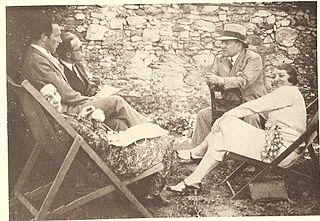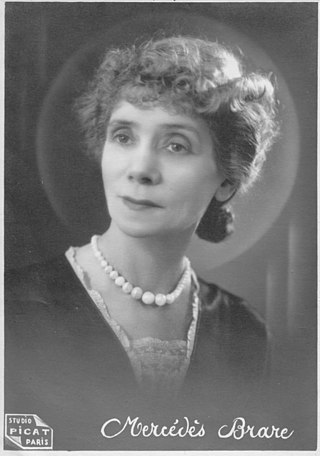
Jean Marie Lucien Pierre Anouilh was a French dramatist whose career spanned five decades. Though his work ranged from high drama to absurdist farce, Anouilh is best known for his 1944 play Antigone, an adaptation of Sophocles' classical drama, that was seen as an attack on Marshal Pétain's Vichy government. His plays are less experimental than those of his contemporaries, having clearly organized plot and eloquent dialogue. One of France's most prolific writers after World War II, much of Anouilh's work deals with themes of maintaining integrity in a world of moral compromise.
The Waltz of the Toreadors is a 1951 play by Jean Anouilh.

Christophe Colomb is an opera in two parts by the French composer Darius Milhaud. The poet Paul Claudel wrote the libretto based on his own play about the life of Christopher Columbus, Le Livre de Christophe Colomb. The opera was first performed at the Staatsoper, Berlin, on 5 May 1930 in a German translation by Rudolph Stephan Hoffmann. Milhaud thoroughly revised the work and produced a second version around 1955. The opera is on a large scale and requires many resources for its staging. As in many of his other works, Milhaud employs polytonality in parts of the score.

Théâtre Hébertot is a theatre at 78, boulevard des Batignolles, in the 17th arrondissement of Paris, France.

Léocadia is a play by Jean Anouilh that premiered at the Théâtre de la Michodière in Paris on 2 December 1940. It is one of Anouilh's Pièces roses, together with Humulus le muet (1932), Le Bal des voleurs (1938), and Le Rendez-vous de Senlis (1941). For the occasion, Francis Poulenc composed one of his most celebrated songs, "Les Chemins de l'amour", sung by Yvonne Printemps.
Y'avait un prisonnier is a play by French dramatist Jean Anouilh. It consists of three acts and was first performed at the Theatre of the Ambassador's in Paris in 1934.
Yvette Etiévant (1922–2003) was a French actress. She starred in Yves Robert's War of the Buttons in 1962.

The Théâtre de Paris is a theatre located at 15, rue Blanche in the 9th arrondissement of Paris. It includes a second smaller venue, the Petit Théâtre de Paris.
Travelling Light or variations may refer to:

Andrée Micheline Ghislaine Tainsy was a Belgian actress. She worked with several notable actors like Philippe Noiret, Jean Louis Trintignant, Charlotte Rampling and famous directors like Claude Chabrol, Costas Gavras and François Ozon. Tainsy began her career with theater plays and her first film debut was in 1945, followed by over 80 different cinema and TV works as co-star. She worked until the day of her death.
Julien Bertheau was a French actor.

Gisèle Casadesus was a French actress, who appeared in numerous theatre and film productions. She was an honorary member of the Sociétaires of the Comédie-Française, Grand Officer of the Legion of Honor, Officer of the Ordre des Arts et des Lettres, and Grand-Croix of the National Order of Merit. In a career spanning more than 80 years, Casadesus appeared in more than a dozen films after turning 90.

Traveling Light is a 1944 French drama film directed by Jean Anouilh, starring Pierre Fresnay and Blanchette Brunoy. The narrative is set in 1931, when a man with amnesia tries to recover his memories from World War I, in order to find out what kind of man he really is. The film is based on Anouilh's 1937 play with the same title.
Albert Rieux was a French stage and film actor.

The théâtre des Mathurins, also called Les Mathurins, is a Parisian theatre located 36, rue des Mathurins in the 8th arrondissement of Paris established in 1897.
Paulette Pax was a French actress, theatre director and scenographer.

Nina Myral, stage name of Eugénie, Hortense Gruel, was a 20th-century French actress, dancer and singer.

Mercédès Brare was a French actress active in film roles from the 1930s to the 1950s.

The Théâtre de la Michodière is a theatre building and performing arts venue, located at 4 bis, rue de La Michodière in the 2nd arrondissement of Paris. Built by Auguste Bluysen in 1925 in Art Deco style, it has a tradition of showing boulevard theatre.
Alain Mottet was a French actor.











